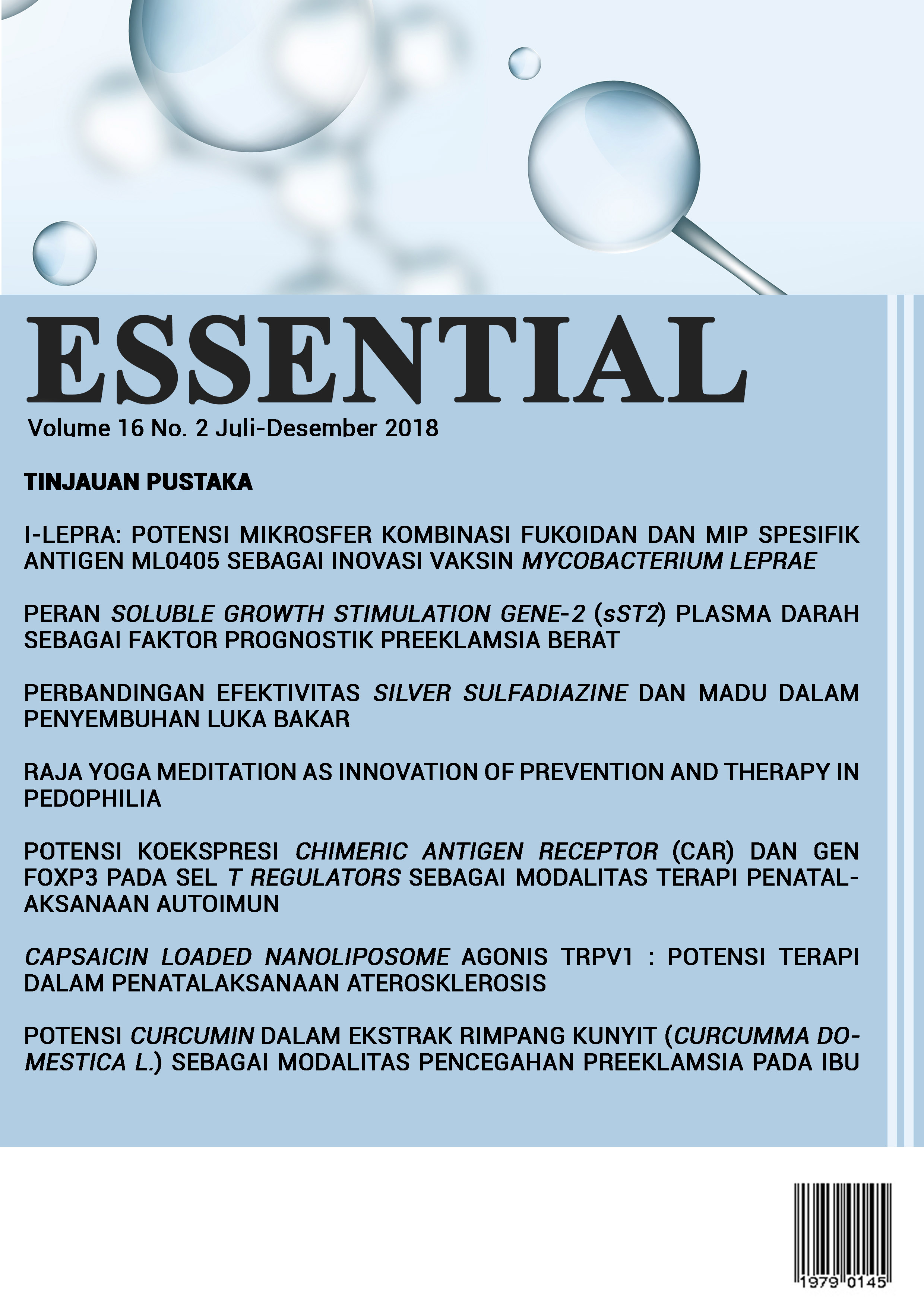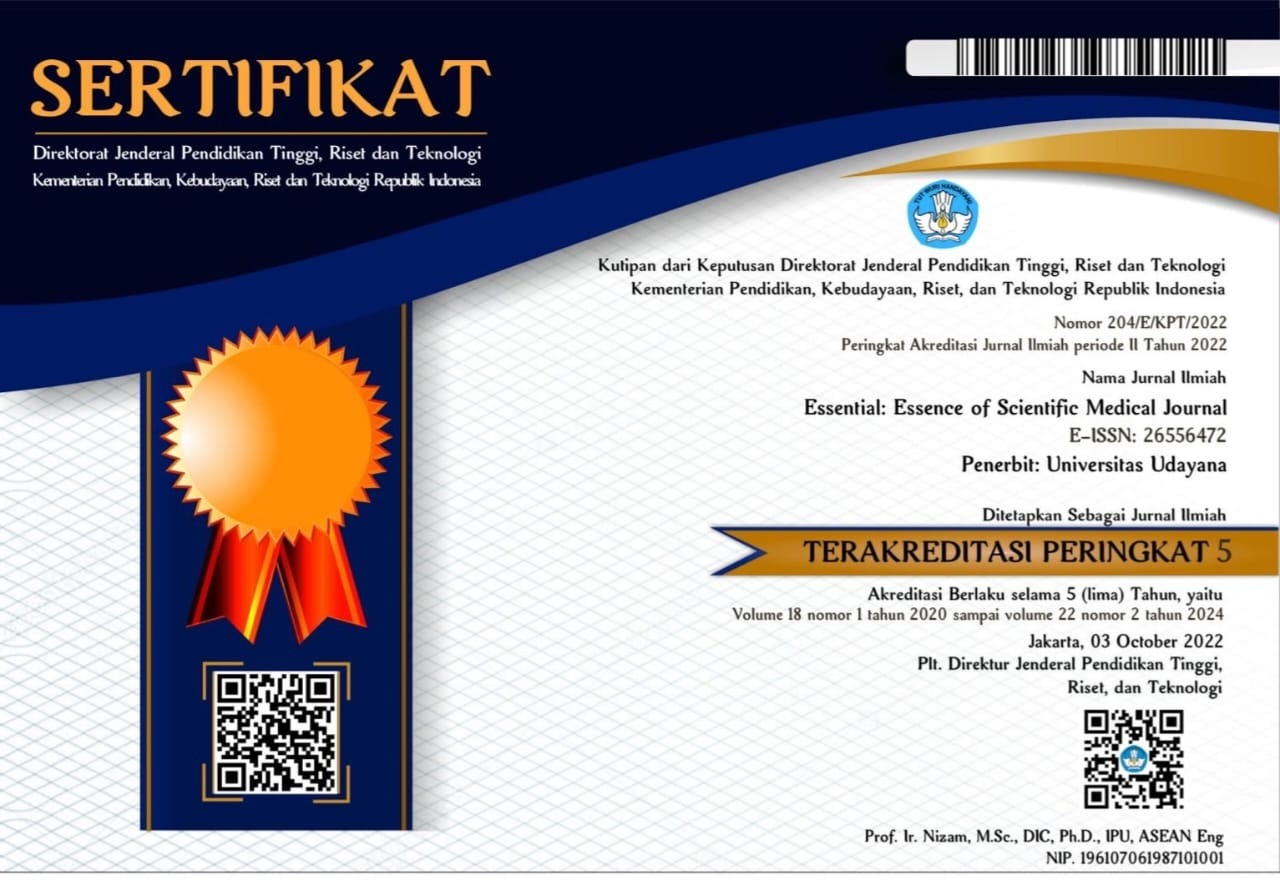i-LEPRA: POTENSI MIKROSFER KOMBINASI FUKOIDAN DAN MIP SPESIFIK ANTIGEN ML0405 SEBAGAI INOVASI VAKSIN Mycobacterium leprae
Abstract
Introduction: Leprosy is a chronic infectious disease that caused by M. leprae, which has predilections to skin and peripheral nerve. WHO predicts that there are aproximately 12 million people world-wide suffered from leprosy, and almost 80% come from tropical countries. Nowadays, leprosy becomes main problem from medical and social views. Prevention of leprosy appears to be a promising strategy in order to eradicate leprosy. In this case, vaccination is the most suitable strategy. Unfortunately, these day vaccines only have protective efficacy less than 70%. More proactive strategies are necessary in order to develop specific vaccine which enhance immune system against M. leprae.
Method: This study used literature reviews, using database from www.pubmed.com and scholar.google.com that met the inclusion criteria. From 108 journals, we obtained 78 journals.
Discussion: MIP is well-known to be an effective vaccine that has been through clinical trial test phase III. MIP has shown some cross-reactive component antigen which can enhance T cell response to M. leprae. Furthermore, the combination with fucoidan microsphere and antigen specific ML0405 which has predilection for machrophage and as immunomodulator, can maximize the ability of MIP as vaccine to prevent leprosy. Product of combination MIP specific antigen ML0405 and fucoidan microsphere called i-LEPRA. Conclusion: However, further research is needed to identify i-LEPRA efficacy and efficiency. Therefore, i-LEPRA is expected to be effective and efficient as an innovative vaccine against M. leprae in the future.
Downloads
References
2. WHO Expert Committee on Leprosy. 7th Report. Technical Report Series 874. Geneva: WHO, 1998.
3. World Health Organization. Leprosy weekly epidemiological record [Internet]. World Health Organization. 2013 [diakses pada tanggal 27 Mei 2017]. Tersedia di: http://www.who.int/wer/2013/wer8835/en/
4. Sehgal VN, Sharma V. Reactions in leprosy – a prospective study of clinical, bacteriological, immunological and histopathological parameters in thirty-five Indians. J Dermatol. 1988; 15: 412 – 419.
5. Lastória JC, de Abreu MAMM. Leprosy: review of the epidemiological, clinical, and etiopathogenic aspects - Part 1. Anais Brasileiros de Dermatologia. 2014;89(2):205-218. doi:10.1590/abd1806-4841.20142450.
6. Sehgal VN, Srivastava G, Sundharam JA. Immunology of reactions in leprosy. Int J Dermatol 1988; 27: 396 – 399.
7. Sehgal VN, Sardana K. Lepra vaccine. Skin Med. 2004; 3: 167–168.
8. World Health Organization. Global leprosy strategy 2016 – 2020: accelerating towards a leprosy-free world [Internet]. New Delhi World Health Organization Regional Office for South-East Asia. 2016 [diakses pada tanggal 27 Mei 2017]. Tersedia di: http://www.wpro.who.int/leprosy/documents/globalleprosystrategy2016-2020.pdf
9. Kaur I, Dogra S, Kumar B, et al. Combined 12-month WHO/ MDT MB regimen and Mycobacterium w. vaccine in multibacillary leprosy: a follow-up of 136 patients. Int J Lepr Other Mycobact Dis. 2002; 70: 174 – 181.
10. Bhattacharya SN, Sehgal VN. An re-appraisal of drifting scenario of leprosy multi-drug therapy (MDT): a proposal for fresh approach in the new millennium. Int J Dermatol. 2002; 41: 321 – 326.
11. Soebono, Hardyanto. Pengembangan vaksin lepra. 1991:1-49.
12. Whitty C. Mycobacterium w. immunotherapy in leprosy. Lepr Rev. 1998;69:222-224.
13. Zaheer SA, Beena KR, Kar HK, et al. Addition of immunotherapy with Mycobactreium w vaccine to multidrug therapy benefits multibacillary patients. Vaccine. 1995; 13: 1102 – 1110.
14. Karonga Prevention Trial Group. Randomized controlled trial of single BCG, repeated BCG, or combined BCG and killed Mycobacterium leprae vaccine for prevention of leprosy and tuberculosis in Malawi. Lancet. 1996; 348: 17 – 24.
15. Sehgal VN, Gautam RK, Sharma VK. Immunoprofile of reaction in leprosy. Int J Dermatol. 1986; 25: 240 – 244.
16. Fitton, J. Therapies from fucoidan; multifunctional marine polymers. Mar. Drugs. 2011;9: 1731–1760.
17. Ohshiro T, Ohmoto Y, Ono Y, Ohkita R, Miki Y, Kawamoto H, Izumi Y. Isolation and characterization of a novel fucoidandegrading microorganism. Biosci Biotechnol Biochem. 2011;74 (8):1729–1732.
18. Fitton, J.H.; Dell’Acqua, G.; Gardiner, V.A.; Karpiniec, S.S.; Stringer, D.N.; Davis, E. Topical benefits of two fucoidan-rich extracts from marine macroalgae. Cosmetics. 2015;2:66–81.
19. Zhou S, Deng X, Li X. Investigation on a novel core-coated microspheres protein delivery system. Journal of Controlled Release. 2001;75:27–36.
20. Naafs B, Silva E, Vilani-Moreno F, et al. Factors influencing the development of leprosy: an overview. Int J Lepr. 2001;69(1):26-33.
21. Martins A, Miranda A, Oliveira M, Bührer-Sékula S, Martinez A. Nasal mucosa study of leprosy contacts with positive serology for the phenolic glycolipid 1 antigen. Brazilian Journal of Otorhinolaryngology. 2010;76(5):579-587.
22. Job CK, Jayakumar J, Kearney M, Gillis TP. Transmission of leprosy: a study of skin and nasal secretions of household contacts of leprosy patients using PCR. 2008;78(3):518-21.
23. Nunzi E, Massone C. Leprosy: A Practical Guide. 1st ed. Milan: Springer; 2012.
24. Masaki T, McGlinchey A, Cholewa-Waclaw J, Qu J, Tomlinson SR, Rambukkana A. Innate Immune Response Precedes Mycobacterium leprae–Induced Reprogramming of Adult Schwann Cells. Cellular Reprogramming. 2014;16(1):9-17.
25. Pinheiro RO, de Souza Salles J, Sarno EN, Sampaio EP. Mycobacterium leprae–host-cell interactions and genetic determinants in leprosy: an overview. Future microbiology. 2011;6(2):217-230. doi:10.2217/fmb.10.173.
26. Parameswaran N, Patial S. Tumor Necrosis Factor-α Signaling in Macrophages. Critical reviews in eukaryotic gene expression. 2010;20(2):87-103.
27. Yang D, Shui T, Miranda J, Gilson D, Song Z, Chen J et al. Mycobacterium leprae-Infected Macrophages Preferentially Primed Regulatory T Cell Responses and Was Associated with Lepromatous Leprosy. PLOS Neglected Tropical Diseases. 2016;10(1):e0004335.
28. Bhat RM, Prakash C. Leprosy: An Overview of Pathophysiology. Interdisciplinary Perspectives on Infectious Diseases. 2012;2012:181089.
29. Talwar GP, Ahmed N, Saini V. The use of the name Mycobacterium w for the leprosy immunotherapeutic bacillus creates confusion with M. tuberculosis-W (Beijing strain): A suggestion. Infect Genet Evol. 2007.
30. Zaheer SA, Mukherjee R, Ramkumar B, Misra RS, Sharma AK, et al. Combined multidrug and Mycobacterium w vaccine therapy in patients with multibacillary leprosy. J Infect Dis. 1993;167(2):401–410.
31. Gershons, R. K. A disquisition on suppressor T cells. Transplant Rev. 1975;26:170-185.
32. David, J. R., Al-askari, S., Lawrence, H. S. and Timms, L. Delayed hypersensitivity in vitro. I.The specificity of inhibition of cell migration byantigens. J. Immunol. 1964;93:264-273.
33. Mendez-Samperio P. Lamb J. Bothamley G. et al. Molecular study of T cell repertoire in family contacts and patients with leprosy. J Immunol. 1989; 142:3599-604.
34. David, J. R. and David, R. R. Cellular hyper-sensitivity and immunity. Inhibition of macro-phage migration and the lymphocyte mediators. Prog. Allergy. 1972;16:300-449.
35. OttenhoffTMH. Converse P.I. Gebre N. Wondimu A. Bhrenberg JP, Kiessling R. T ceil responses to fractionated Mycobacterium ieprac antigens in leprosy. The lepromatous nonresponder defect can be overcome in vitro by stimulation with fractionated M. leprae components. Eur J Immtinol. 1989;19:707-13,
36. Converse PJ, OttenhofTTHM. Gebre N. Ehrenberg JM. Kiessling R, Ceilular, Humoral, and gamma interferon responses to Mycobacterium leprae and BCG antigens in healthy individuals exposed to leprosy. Scand J Immunol. 1988:27:515-25.
37. Dockrol HM, Sloker NG, Lee SP. et id. T-cell recognition of the IX-Ki!odallon antigen of Mycobacterium leprae. Infect Immun. 1989:57:1979 83.
38. Mehra V. Bloom BR, Torigian VK. et al. Charactherization of Mycobacterium leprae cell wall-associated proteins with the use of T lymphocyte clones. J Immunol. l959;|42:2873-8.
39. Mehra, V., L. H. Mason, W. Rothman, E. Reinherz, S. F. Schlossman, and B. R. Bloom. 1980. Delineation of a human T cell subset responsible for lepromin induced suppression in leprosy patients. J. Immunol. 125:1183-1188.
40. Yamamura M, Uyemura K, Deans RJ, Weinberg K, Rea T, Bloom BR, Modlin R. Defining protective responses to pathogens: Cytokine profiles in leprosy lesions. Science. 254;1991:277-279
41. Sampaio L, Stefani M, Oliveira R, Sousa A, Ireton G, Reed S et al. Immunologically reactive M. leprae antigens with relevance to diagnosis and vaccine development. BMC Infectious Diseases. 2011;11(1).
42. Kim WJ, Kim SM, Lee YH, Kim HG, Kim HK, Moon SH, Suh HH, Jang KH, Park YI. Isolation and characterization of marine bacterial strain degrading fucoidan from Korean Undaria pinnatifida sporophylls. J Microbiol Biotechnol. 2008;18(4):616–623.
43. Chevolot L, Mulloy B, Ratiskol J, Foucault A, Colliec-Jouault SA. Disaccharide repeat unit is the major structure in fucoidans from two species of brown algae. Carbohydrate Research 2001;330:529–535.
44. Janes KA, Cavlo P, Alonso MJ. Polysaccharide colloidal particles as delivery systems for macromolecules. Advanced Drug Delivery Reviews. 2001;47:83–97.
45. Walia R, Sarathchandra KG, Pandey RM et al. Field trials on the use of Mycobacterium w vaccine in conjunction with multi drug therapy in leprosy patients for immunotherapeutic and immunoprophylactic purposes. Lep Rev 1993;64:302– 311.
46. Nerland AH, Mustafa AS, Sweetser D, Godal T, Young RA. A protein antigen of Mycobacterium leprae is related to a family of small heat shock proteins. J. Bacteriol. 1988;170:5919–5921
47. Fitton, J.H.; Dell’Acqua, G.; Gardiner, V.A.; Karpiniec, S.S.; Stringer, D.N.; Davis, E. Topical benefits of two fucoidan-rich extracts from marine macroalgae. Cosmetics. 2015;2:66–81.
48. Zhang W, Oda T, Yu Q, Jin JO. Fucoidan from macrocystis pyrifera has powerful immune-modulatory effects compared to three other fucoidans. Mar. Drugs. 2015;13:1084–1104.
49. Sezer AD, Akbug˘a J. Release characteristics of chitosan treated alginate beads I: Sustained release of a macromolecular drug from chitosan treated alginate beads. Journal of Microencapsulation 1999;16:195–203.
50. Irhimeh MR, Fitton JH, Lowenthal RM, Kongtawelert P. A quantitative method to detect fucoidan in human plasma using a novel antibody. Methods Find. Exp. Clin. Pharmacol. 2005;27:705–710.
51. Teruya, T.; Tatemoto, H.; Konishi, T.; Tako, M. Structural characteristics and in vitro macrophage activation of acetyl fucoidan from Cladosiphon okamuranus. Glycoconj. J. 2009, 26, 1019–1028.
52. Zhang W, Oda T, Yu Q, Jin JO. Fucoidan from macrocystis pyrifera has powerful immune-modulatory effects compared to three other fucoidans. Mar. Drugs. 2015;13:1084–1104.
53. Geluk A, Klein MR, Franken K, van Meijgaarden KE, Wieles B, Pereira KC, Bührer-Sékula S, Klatser PR, Brennan PJ, Spencer JS, et al. Postgenomic approach to identify novel Mycobacterium leprae antigens with potential to improve immunodiagnosis of infection. Infect. Immun. 2005;73:5636–5644.
54. Ale MT, Mikkelsen JD, Meyer AS. Important determinants for fucoidan bioactivity: A critical review of structure-function relations and extraction methods for fucose-containing sulfated polysaccharides from brown seaweeds. Mar. Drugs. 2011;9: 2106–2130.
55. Talwar G, Singh P, Atrey N, C Gupta J. Making of a highly useful multipurpose vaccine. Journal of Translational Science. 2016;2(1).
56. Sharma P, Mukherjee R, Talwar P et al. Immunoprophylactic effects of anti-leprosy vaccine in household contacts of leprosy patients: clinical field trials with a follow-up of 8-10 years. Lepr Rev. 2005;76:127-43.
57. Britton WJ, Martin E, Kamath AT et al. Immunoprophylaxis against Mycobacterium leprae infection with subunit vaccines. Lepr Rev. 2000;71:176–181.
58. Gupte MD, Vallishayee RS, Anantharaman DS et al. Comparative leprosy vaccine trail in South India. Ind J Lepr. 1998; 70:369– 388.
59. Sharma P, Kar HK, Kaur H et al. Induction of lepromin positivity and immunoprophylaxix in household contacts of multibacillary leprosy patients: a Pilot study with a candidate vaccine Mycobacterium w. Int J Lepr. 2000;68:136–142.
60. Fine PE. South Indian leprosy vaccine trial: important lessons for mycobacterial immunology. Lepr Rev. 1999;70:247–249.
61. Walia R, Sarathchandra KG, Pandey RM et al. Field trials on the use of Mycobacterium w vaccine in conjunction with multi drug therapy in leprosy patients for immunotherapeutic and immunoprophylactic purposes. Lep Rev 1993;64:302– 311.
62. De Sarkar A, Kaur I, Radotra BD, Kumar B. Impact of combined Mycobacterium w vaccine and 1 year MDT on multibacillary leprosy patients. Int J Lepr other Mycobact Dis. 2000;69:187–194.
63. Katoch K, Katoch VM, Natrajan M et al. Treatment of bacilliferous BL/LL cases with combined chemotherapy and immunotherapy. Int J Lepr other Mycobact Dis. 1995;63:202–-212.
64. Sharma P, Misra RS, Kar HK et al. Mycobacterium w vaccine, a useful adjuvant to multidrug therapy in multibacillary leprosy: a report on hospital based trials with a follow-up of 1–7 years after treatment. Lepr Rev. 2000; 71:179–192.
65. Talwar GP, Mukherjee R, Zaheer SA et al. Present approaches to immunotherapy and immunoprophylaxis in leprosy. In: Talwar GP (ed) Progress in Vaccinology, vol. II. Springer-Verlag, New York, 1989, pp. 301–311.
66. Talwar GP, Zaheer SA, Mukherjee R et al. Immunotherapeutic effects of a vaccine based on a saprophytic cultivable mycobacterium, Mycobacterium w, in multibacillary leprosy patients. Vaccine. 1990;8:121–129.
67. Raghavendran, H.R.; Srinivasan, P.; Rekha, S. Immunomodulatory activity of fucoidan against aspirin-induced gastric mucosal damage in rats. Int. Immunopharmacol. 2011;11:157–163.
68. Andrade LR, Salgado LT, Farina M, Pereira MS, Mour PAS, Amado FGM. Ultrastructure of acidic polysaccharides from the cell walls of brown algae. Journal of Structural Biology. 2004;145:216–225.
69. Vandenberg GW, Nou¨ e J. Evaluation of protein release from chitosan-alginate microcapsules produced using external or internal gelation. Journal of Controlled Release 2001;18:433–441.
70. Mitrasinovic OM, Murphy GM Jr. Accelerated phagocytosis of amyloid-beta by mouse and human microglia overexpressing the macrophage colony-stimulating factor receptor. J Biol Chem. 2002;277:29889–29896.
71. Trinchero J, Ponce NMA, Córdoba OL, Flores ML, Pampuro S, Stortz CA, Salomón H, Turk G. Antiretroviral activity of fucoidans extracted from the brown seaweed Adenocystis utricularis. Phytother Res. 2009; 23:707–712.
72. Rvantseva AM, Bakunina IIu, Nedashkovskaia OI, Kim SB, Zviagintseva TN. Distribution of intracellular fucoidan hydrolases among marine bacteria of the family Flavobacteriaceae. Prikl Biokhim Mikrobiol. 2006;42(5):552–559.
73. Wang J, Zhang Q, Zhang Z, Song H, Li P. Potential antioxidant and anticoagulant capacity of low molecular weight fucoidan fractions extracted from Laminaria japonica. Int J Biol Macromol. 2010;46: 6–12.
74. Wang J, Wang F, Zhang Q, Zhang Z, Shi X, Li P. Synthesized different derivatives of low molecular fucoidan extracted from Laminaria japonica and their potential antioxidant activity in vitro. Int J Biol Macromol. 2009;44(5):379–384.
75. Wang J, Zhang Q, Zhang Z, Zhang J, Li P. Synthesized phosphorylated and aminated derivatives of fucoidan and their potential antioxidant activity in vitro. Int J Biol Macromol. 2008;44:170–174.
76. Tokita, Y.; Nakajima, K.; Mochida, H.; Iha, M.; Nagamine, T. Development of a fucoidan-specific antibody and measurement of fucoidan in serum and urine by sandwich elisa. Biosci. Biotechnol. Biochem. 2010;74:350–357.
77. Silchenko AS, Kusaykin MI, Kurilenko VV, Zakharenko, AM, Isakov VV, Zaporozhets TS, Gazha AK, Zvyagintseva TN. Hydrolysis of fucoidan by fucoidanase isolated from the marine bacterium, formosa algae. Mar. Drugs. 2013;11:2413–2430.
78. Pomin, V.H. Sea, carbohydrates and clotting: A triad on the road of drug discovery. Mini Rev. Med. Chem. 2014;14:717–724.


 SUBMISSION
SUBMISSION
















